Dr. Levin’s Golden Mean Dental Gauge and Grids apply the golden section to dental aesthetics. These gauges and grids, as shown below, are available at http://www.goldenmeangauge.co.uk.
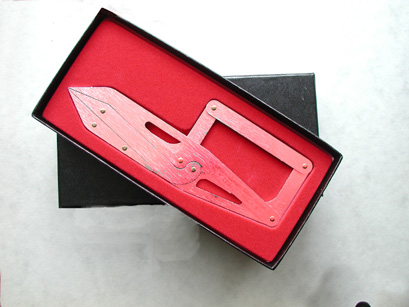 |
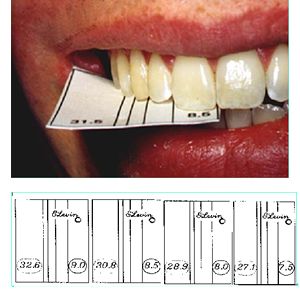 |
Dr. Levin’s Phi Dental Grid, developed by PhiMatrix, is a software implementation of the very same principles, allowing practitioners to apply Dr. Levin’s concepts of dental aesthetics to digital photographs, which are quickly gaining popularity as the medium of choice for documentation, analysis and design in dental aesthetics and orthodontics.
The concepts and application of proportions based on phi, the golden section, are the identical. While the article below addresses use of the steel gauge and plastic grids available for years, the instructions below can be applied directly to the use of the Phi Dental Grid Software.
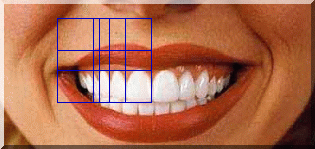
Introduction
What is beauty?. Is beauty only in the eye of the beholder, or are there some absolute values? Beauty is a mystery! “I know not what beauty is, but I know that it touches many things”, Dürer.
If we study the beauty of nature, teeth, or art we will discover a common principle running throughout. This common principle is the universal recognition of pleasant proportion. We all have a natural understanding of good proportion much in the same way as we know how to divide a line in half or erect a perpendicular. We easily agree that an object of art has good or bad proportion, or that this face looks too long, or too short and out of proportion. This magical connecting thread of proportion, known since antiquity, is none other than the Golden Proportion, a phenomenon related to beauty.
The following notes illustrate just a few facets of the mystery and magic of this proportion. The understanding of this concept will enable the reader to take a first step on a journey of discovery into an unexpected dimension of beauty which affects our lives at every turn. It is one of the building blocks of beauty that we can easily apply to our dental work, confident of success.
THE CONCEPT Whilst the concept of the Golden Proportion is easy to understand, attempts at the application have proved complex and difficult to explain. Its very simplicity has been perplexing. This enchanting proportion has thus not been appreciated at large.
Proportion usually implies a relationship between a larger and a smaller., Fig 1 shows a number of pairs of lines of different lengths and their ratio to each other. The last line shows the ratio of 1 to 0.618. This is the simplest form of the universally acclaimed GOLDEN PROPORTION.
 |
|
Figure 1 |
In order to be able to asses the Golden Proportion quickly and accurately an instrument, the GOLDEN MEAN GAUGE, as shown in fig 2, was developed which shows the points superimposed on the line divided into the Golden Proportion.
 |
| Figure 2 |
Fig 3 shows the points of the gauge superimposed on the dominant land marks of natural beauty.
 |
 |
 |
| Figure 3 | ||
The BASIC Pattern of the Golden Proportion is illustrated in Fig 4 and shows a line divided into a larger and a smaller part. When the Ratio between B and A is in the Golden Proportion then A is 1.618 times Larger than B. This is the same as saying that A is to B as 1 is to .618 which is the reciprocal (not clinically important but magical).
| A | 1 | A+B | 1.618 | |||||
| —– | —– | = | —– | —– | ||||
| B | .618 | A | 1 |
Dental Applications
Fig 4 shows a Golden Mean Gauge superimposed on a photograph of the upper incisors demonstrating that the width of the upper central incisor is in the Golden Proportion to the width of the lateral incisor. This was the first discovery in a journey into the magic of beauty.
 |
| Figure 4 |
Not only are the widths of the 2 incisors in the Golden Proportion but all eight of the front teeth showing in the smile are in the Golden Proportion to each other, from central incisor to premolar on both sides as will be shortly explained.
THESE ARE WIDTHS, AS SEEN …NOT AS MEASURED.
This is the beautiful appearance we present when we meet socially. Regrettably many of my colleagues are still trying to measure the actual widths.
The 4 tooth incisor grids
The most important and most useful tool for the application of the Golden Proportion to dental aesthetics is the set of grids constructed in the Golden Proportion .
There are two forms of the grid in the set.
1. A set of transparencies to use on photographs to learn the principles.
2. A booklet of hygienic disposable tear-off grids for use in the mouth
The grid shows the critically important relationships between
A Teeth, from central incisor to premolar
B Teeth and width of smile
The 7 grids all follow the pattern of the adjacent diagram. There are 4 spaces for the 4 front teeth of the anterior aesthetic segment, from central incisor to first premolar unilaterally.
The number in the solid circle on the bottom right of the rectangle i.e. 8.5 refers to the width of the central incisor.
 |
| Figure 5 |
The grid reaches from the midline between the central incisors on the one end of the grid, to the buccal surface of the 1st premolar on the other end. You can expect every natural tooth of the anterior aesthetic segment to fit very well into each space of the grid. The width of each space is in the Golden Proportion to the spaces on either side.
The grid also shows that the width of the 4 front teeth all together are in the Golden Proportion to the width of the smile. The 30.8 measurement refers to the width of the smile, easily measurable, simply divide in half, because you are only considering half the width of the smile.
In the kit you will find a set of 20 grids of different sizes printed on a transparency. Find a picture of an attractive smile, preferably from a frontal view and match a grid to the smile.
When testing with the grids, you have to realise that these are the widths as seen from the front in the optimum aesthetic position, the face to face position, where our encounters with other people usually start.
Using transparent grids on photographs
Use the transparent grid of the four front teeth and superimpose it on photographs of the front teeth of large pictures of smiling faces taken from the front. as seen in fig 6 Most of these exercises require reasonably large photographs of people’s faces with attractive smiles of the type abundantly found in the glossy magazines.
 |
 |
| Figure 6 | |
One end of the grid must coincide with the midline and the other end coincides with corner of the smile. Use different sized grids until you find that all the teeth from central to canine fit the grid. You should find that 95% of the time all the naturalfour front teeth from central to premolar fit the grids almost exactly Repeat this exercise with numerous photographs of upper front teeth until you are comfortable with it.
GRIDS ON PATIENTS
Find a patient with a reasonably good looking set of front teeth. Measure the approximate width of the central incisor and select and tear off an appropriate sized grid and test it in the mouth in the same way that you did with the photographs.
GOLDEN PROPORTIONS BETWEEN TEETH ON DENTAL CASTS
Use the paper grids with models in the same way as transparencies on photographs or the grids in the mouth Measure the width of the central incisor to the nearest half a millimetre and select the appropriate grid using the number in the solid circle.
 |
| Figure 7 |
Put the grid on the table and place the model over the grid so that the central incisor fits over the space for central incisor. One end of the grid must coincide with the midline and the other end coincides with the buccal surface of the 1st premolar. Move the grid around until you find that all the teeth from central to canine fit the grid. You should find that 95% of the time all the natural four front teeth from central to premolar fit the grids. The grids make it much easier for the technician to develop his aesthetics
THE BASIC GRAPH
The basic Graph as shown in Fig 3 shows a base line OX with 2 angular lines radiating from O,. . OA and OB so that BA is to AX as 1 is to 1.618 (or 0.618 is to 1.) Any perpendicular dropped from the line OB to the line OX cuts through line OA in the same proportion.
 |
| Figure 8 |
If you do not yet have a gauge then substitute the BASIC GOLDEN PROPORTION GRAPH for any photographs showing the Golden Mean Gauge.
To determine the size of a replacement lateral or veneer or crown on the lateral.
Where there is a problem of the upper lateral incisor, e.g. a situation where the lateral does not look too good or where there are spaces between the lateral and central or where you are going to put a facing on the lateral.
Step 1 – Measure the width of the central and tear off the appropriate sized grid.
Step 2 – Position it in the mouth to see how the grid lines up to the teeth. The central and premolar should fit the grid exactly in the same way as you did with the models of good looking natural teeth.
Step 3 – You can now assess where and how the lateral should be built up.
Step 4 – Build it up with cold-cure acrylic or light cure composite material and shape it approximately.
Step 5 – Cure it. Apply the grid either now or while you are building up and trim to shape and size. (no need to etch the composite into place, because this is only a temporary mock-up). If you wish however you can do a little pinpoint of etchant, just to help hold it in place.
Step 6 – Show the patient the temporary facing or crown facing and get their approval and agreement of the positions and proportions. It can be very helpful for the technician to copy this position by making an index or an aliginate
Determining the width of the arch
Superimpose the transparent grid on pictures of teeth in smiling faces (pictures taken from the front as before) and line up the incisal end of the grid between the midline as before and with the buccal end on the buccal surface of the premolars as before, but now notice where the far end of the grid locates. It usually is very close to the corner of the smiling mouth. Confirm this on a number of photographs i.e. that the corner of the mouth line indeed lines up with the corner of the mouth. The width of the arch, (that is the width of the four front teeth) is related to the width of the smile. If the 4 front teeth are wide in a broad arch then the smile will be wide and conversely if the arch is narrow and tapered then the width of the smile will be narrow. The Grids will show that the arch is framed by the lips and the neutral space.
If we have a beautiful picture, we seem to like to frame it. Our natural smiles are similarly framed. The upper and lower borders of the frame are easy to visualise as the upper and lower smiling lips. The lower border of the frame is made by the lower lip which follows the curve of the incisal edge of the upper front teeth whilst the upper border of the frame is the upper lip in line with the necks of the teeth during the smile. The vertical side of the frame is a little more difficult to visualise. It is formed by a subtle dark space on the side of the smile between the front eight teeth and the corner of the smile.. In the attractive smile, we see that the space between the teeth and the corner of the smile form a backdrop in which the anterior aesthetic segment is featured. The width of this space is in the Golden Proportion to the width of teeth showing up to the midline.
The 8 spaces for the anterior aesthetic segment are in the Golden Proportion to the total width of the smile. The whole of the smile is in the Golden Proportion to the width of the teeth showing in the smile The notes on page 249 of the 1978 article headed the “BILATERAL FORM” and included with this set, will clarify this theory with further examples.
The grids will help with full dentures when sometimes it can be especially difficult to determine exactly how wide to make the arch in the canine area or how much to emphasis a dominant feature at the corner of the arch.
Confirm the width of the arch from the eye measurements
Notice a gauge superimposed on a picture of the eyes as in fig 9. This shows that the width of the bridge of the nose to the white of the eyes is in the Golden Proportion. The Gauge should be used on photographs in order to prevent scratching the patient with the points. Alternately, mark the eye distances on a card and then use the gauge on the card.
 |
| Figure 9 |
The space between the white of the eyes (bridge of nose) is in the golden proportion to the white of the eyes.
Notice the detail of the canthus. The gauge stretches from the edge of the medial canthus on the bridge of the nose to the opposite medial edge of the canthus. The white of the eyes is that part between edge of the mesial and lateral canthus. The white part of the eye is in the Golden Proportion to the distance between the eyes across the bridge of the nose.
Notice on photographs that the width of the nose bridge plus the width of the eyes is equal to the width of the smile.
The white of the eyes is in the Golden Proportion to the white of the teeth. This is explained in fig 15 page 251.of the original article of 1978.
Confirm this on patients and photographs by making these measurements across the bridge of the nose and eyes with pencil marks on a paper card, and confirm that this measurement equals the width of the smile.
Height of the lip line
In the relaxed face, where the teeth are not touching together (when the lower jaw is in the rest position with free way space present) the lip line divides the lower third of the face into the Golden Proportion. The space between the bottom of the nose and the bottom of the chin is divided by the lip line into a ” chin to lip line” (the larger part) and a smaller part the “lip line to the nose” The smaller to the larger is in the Golden Proportion as illustrated in figure 15a+b.
 |
| Figure 10 |
These photographs illustrate the Golden Mean Gauge showing the lip line as well as the incisal edge of the incisors in the smile. You can also use the basic graph on pictures to study this relationship. Move the transparent graph horizontally along the smile until you the 3 points coincide along one perpendicular
The Golden Proportion gives good guidance for the position of the height of the incisors but this only applies in about 75% of the population. Just as important is phonetics and incisal disclusion.
Phonetics
A. The “S” POSITION There should be about 1mms clearance between the of upper and lower incisal edges when the patient counts the sixties.
B. The “F” position The upper incisors should touch the border of wet and dry line on the lower lip when counting the forties and fifties.
C. The “MMM” position When gently ‘humming’, brings lower and upper lips together in a most relaxed position and shows the free way space . ( connect with the Hindu “om” chant for relaxation and meditation).
Disclusion
The length and shape of the palatal surface must be conducive to optimum incisal disclusion.
The Golden Rectangle
The height of the central incisors is in the Golden Proportion to the width of the two centrals as discovered by Dr Stephen Marquardt, an eminent Oral surgeon, in California, as shown in Fig 11 and 12.
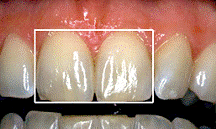 |
| Figure 11 |
 |
| Figure 12 |
As always, the first step is to confirm this formula by applying the transparency of the rectangle grids to large pictures of front teeth. In its simplest form we can recognise the Golden Proportion as the division of a straight line with the Golden Proportion gauge into a larger and a smaller part as in fig (1).
In a Golden Proportion rectangle however, the smaller part is at right angles to the larger part, as shown in fig 13.
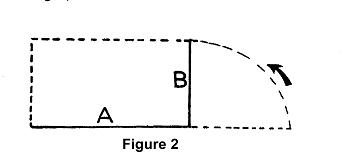 |
| Figure 13 |
A frequent example of this rectangle is the ubiquitous plastic credit card and the telephone card. Fig 14.
 |
| Figure 14 |
This revelation has offered solutions to a host of dental aesthetic problems. The basic pattern of 4 problems are detailed below in figs 5 – 8.of the page headed “Rectangle and grid tutorial” If you have the width, you can determine the height. Conversely, if you have the height, you can calculate the width. If you have the optimum width you can decide how best to close any undesirable spaces between the teeth.
The Golden Proportion grids show the inter-tooth relationship between the 8 teeth of the anterior aesthetic segment. These grids are complementary to the Golden Proportion rectangle. The combination of the two gives a powerful tool to confidently determine good aesthetics.
The Fibonacci Series
No consideration of the Golden Proportion can be complete without mention of the Fibonacci Series, which is the complementary view of the Golden Proportion. These numbers are also abundant in the beauties of nature and can even be found in teeth. In this series of numbers each term is the sum of the previous two terms as follows:
0 1 1 2 3 5 8 13 21 34 55 89 etc
34 ÷ 55 = 0.618 or inversely 55 ÷ 34 = 1.618
The Fibonacci series is named after Leonardo of Pisa or (Filius Bonacci), alias Leonardo Fibonacci, born in 1175, whose great book, The Liber Abaci (1202), on arithmetic, was a standard work for 200 years and is still considered the best book written on arithmetic. It was the principal means of demonstrating and introducing the enormous advantages of the Hindu Arabic system of numeration over the Roman System. Leonardo’s reputation amongst scholars was deservedly great. It was so outstanding that King Frederick II, visiting Pisa in 1225, held a public competition in mathematics to test Leonardo’s skill and Leonardo was the only one able to answer the questions. (Huntley, “The Divine Proportion”, Dover publications1970)
Phylotaxis
The most frequently studied aspect of the Fibonacci Series is Phylotaxis, the study of the ordered position of leaves on a stem, ( Phylos – leaf, taxis – order – e.g. filo pastry – thin leaves of pastry) with particular reference to their repetition in the same alignment.
One of the most spectacular examples of the Fibonacci Series in nature is in the head of the sunflower.
 |
| Figure 15 |
Scientists have measured the number of spirals in the sunflower head. They found, not only one set of short spirals going clockwise from the centre, but also another set of longer spirals going anti-clockwise. These two beautiful sinuous spirals of the sunflower head reveal the astonishing double connection with the Fibonacci Series.
The pairs are always adjacent numbers in the Fibonacci Series. These double spirals are also found on pine cones, pineapples, chrysanthemum and dahlias. e.g. one pair could be 21 and 34 and the next pair could be 34 and 55. 34÷ 55 = 0.618 or 55 ÷ 34 = 1.618
The New Scientist FIG 16 December 1981 featured on its cover a daisy head showing the double spiral. The article then went on to discuss the Fibonacci series, showing other examples of the double spirals in nature, comparing them to computer generated double spirals. The writer also postulated an explanation for the way plants’ growth illustrates the Fibonacci Series in the position and spacing of the leaves (phylotaxis).
 |
| Figure 16 |
Although my discovery, in 1975, of the application of the Golden Proportion to dentistry is new, the Golden proportion grids are by no means new. I have been preceded by both Corbusier who made identical grids for architecture and Picasso’s pole as seen in figs 17 and 18.
 |
| Figure 17 |
 |
| Figure 18 |